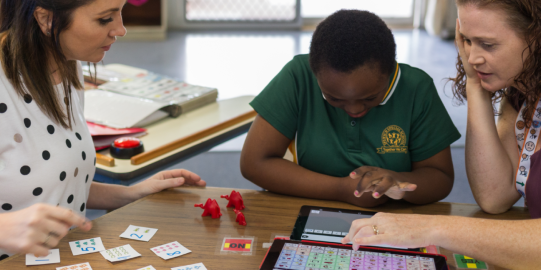My introduction to AAC
The first AAC user joined my classroom in 2011, and I had no idea what I was doing. AAC was brand new for both of us, and we had to figure it out together. It was hard to balance teaching and modeling at the same time. I was slow, and I could never find the right word when I needed it. My students would laugh every time I messed up… and that was often! But slowly, it became easier. I learned more about communication partner skills and was so proud when that student learned to share her thoughts and communicate. She could show me her authentic self. After that, I was hooked. I was motivated to become the best communication partner I could be and ensure every student I taught from then on would have access to a robust AAC system. I spread the word to the other teachers in my school and beyond.
All those years ago, I had to learn on my own, but with my experiences as a teacher since, I have learned how much easier this process would have been with a team strong and supportive AAC team surrounded me.
Building your AAC skills
One of the best places to get started with AAC as a teacher is to build your own personal AAC knowledge and skills. Knowing and doing more with AAC will make you feel more confident contributing to and supporting your team.
So, take the time to get to know the different AAC tools you and your students will access in your classroom. Explore the device for possible words and sentences you need for class lessons and activities. Find fun and exciting things to say. Taking time to get to know the AAC tools can really help. You will feel more confident and ready to try AAC in your classroom.
Make using AAC a habit in your classroom. Make sure the AAC is always available and start modeling, bit by bit. The more you use it, the easier it gets. No one really feels confident when they first begin modeling AAC, but with time and practice, you will!
Ask for help when you need it
You don’t need to do AAC alone, so don’t be afraid to ask for support. Sometimes things might feel like they are not working in the classroom, or they are not working as well as they could be. Remember that the AAC team is there to support you. Reach out and ask for their help. Invite team members to your classroom, brainstorm ideas, and share resources. Working together as a team will lead to the best outcomes for your student.
Focus on your relationship with the AAC user
I had some fantastic teachers when I was a student at school. Many of them are the reason I chose to become a teacher myself. I might not be able to remember all of their names or faces, but I can clearly remember how they made me feel.
Teachers have lots of things to juggle in a classroom. Curriculum, teaching, collecting data, assessments, reporting, the list goes on. But the most important thing we can do as teachers is to build relationships and trust with our students! Prioritize time to build relationships.
If you have an AAC user in your class, take the time to really get to know them. What do they like and dislike? Show that you are interested in them and their life. Let them show you their true personality. Work out how they learn best. Show them that you are there to listen to whatever they want to tell you.
Connect with parents of AAC users
Building strong relationships with parents of AAC users in your classroom is so important. Sometimes this comes easily. Some parents have had great past experiences with schools, and teamwork can start from day one. But this isn’t always the case. It might take parents time to trust you. You might even feel intimidated by things a parent says or does, but remember; this goes both ways. The whole school experience can be intimidating to some parents, even if we, as teachers, aren’t aware of it. You can’t undo prior bad experiences with teachers and schools, but what you can do is make parents’ experiences with you different.
Every time you have a meeting with a parent, think to yourself, how can I ensure this is the best experience for both of us? If there is only one adult-sized chair in the classroom, go and find a second one, or you both sit on the kids’ chairs. If the parent has concerns or opinions, listen and really show that you value their input. It’s important to take time and understand where parents are coming from. They want the absolute best for their child. Listen to them and learn from their experiences. They know their child best.
If the parent is pressuring you to model AAC more at school, use this as an opportunity to reflect. How much do you model AAC during the school day? Sometimes we have those days when everything you have planned seems to fall apart, and when the bell rings, you think, “What did I even do today?” AAC won’t have been used as much as you would have liked on those days. Cut yourself some slack and try again tomorrow. While a single bad day will not hurt, if you are having difficulty modeling consistently in your classroom, that barrier must be overcome. Ask for help. If you have an AAC Coach or Speech Pathologist at your school, they can be a great first port of call. The AssistiveWare Facebook groups are very welcoming and a great place to get support, advice, and ideas. And don’t forget that the AssistiveWare Support team is always there to help.
Suppose the parent doesn’t want to use AAC at home or wants the device left at school. Stop and listen. Maybe they aren’t sure why the device needs to be taken home. Maybe an AAC device just isn’t realistic for the family at this time. They don’t need to explain or justify anything. Work with the parent to identify what is achievable at this time. Maybe they could use a paper-based board as a starting point or embed AAC into one existing family routine. Work with the family to support them in embedding AAC into their home life at a speed that works for them.
Work with Speech-Language Pathologists
Having a Speech-Language Pathologist (SLP) visit the classroom for observation can be a nerve-racking experience, but it doesn’t need to be.
If you welcome an SLP into your classroom, you can set the expectations. If you want them to join the activities, just ask them. If it’s challenging to have goal-setting conversations with a class full of students, let the SLP know and arrange a time when you are not in class. Take the time to think about what is going to work best for you and your class and advocate on your behalf.
SLPs are the experts when it comes to language, but you are the expert of your classroom. Sometimes, teachers can feel intimidated by the complex terminology that they use and the recommendations they make (that may not fit into your busy class routine). Remember, you are an expert too! All members of the AAC team are experts in their own way. Don’t let anyone make you feel like you have less of a voice. If you don’t understand the terminology, ask the SLP to repeat it in plain language. Share your honest thoughts and real experiences with AAC. Even if things are not going well or you haven’t followed through with what the SLP asked you to do. Open and honest communication is key to collaboration. If there are barriers, working together is the only way to solve them!
Take time to learn more about what SLPs do and how they approach AAC. One way to better understand them is to read from their perspective. The better everyone on the AAC team understands each other, the better you can all work together.
Focus on what you can control and contribute to the AAC team
As a teacher, you only have one year with this student in your class, but you have five days a week during the school year! When you think about it, this is a lot of time. Make that time count and think about how you can best support the AAC user from your position as a teacher.
Teachers bring a lot to AAC teams:
- You can engineer your classroom for communication success. Make sure the AAC device is always within arms reach. Stick core boards to the student’s desks. Screen share AAC to an interactive whiteboard at the front of the room. Make AAC posters for the playground and waterproof AAC boards for the swimming pool. Classrooms with AAC available reduce the barriers to learning.
- You can model on the AAC device in the classroom. Through modeling, you can teach the AAC user new vocabulary used in the curriculum and where that vocabulary lives on their device. But don’t just model curriculum language. We communicate for all different reasons. Model how to tell jokes and stories, how to express feelings, ask questions, and so many more reasons.
- You can teach peers to be good communication partners. No child comes to school and only wants to communicate with the teacher. Teach all of the students in your class how to wait, listen and respond.
- You can give communication access to everyone. You never know which child in your class might benefit from AAC.




